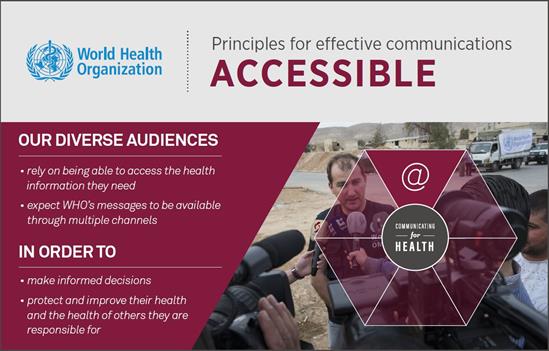
Principle: Accessible
Identify effective channels
Tactics to apply to make your communications accessible
Identify Effective Channels
Communicators need reliable channels for reaching decision-makers, disseminating messages and distributing materials. To identify the best available messaging pathways, communicators should analyse the audience’s access to different channels and
their preferences.
When developing communications strategies, WHO communicators should consider a channel’s reach and influence, for example:
- mass media channels, such as radio, community billboards, and posters on public transportation, have broad reach and can increase issue awareness;
- the effectiveness of mass media channels can vary depending on the target audience and the presence of mass media in their community;
- local radio can be a good channel for disseminating urgent public health information in specific locations; and
- interpersonal channels are especially important when trying to influence attitudes and encourage wider adoption of health behaviours.
Use global channels to reach a broad audience
- international news media;
- websites; and
- social media platforms that touch millions of followers, including Twitter, Facebook, YouTube, Periscope, Google+, Instagram, LinkedIn, Storify, Foursquare and Ello.
Use regional and country office channels to reach targeted audiences with tailored information
Regional and country offices have their own set of communications channels. Some of those may overlap with global, HQ-managed outreach channels. Channels used by WHO at regional and country levels have the advantage of better targeting and reaching audiences geographically and are better able to bring tailored information to the attention of specific audiences with particular interests:
- regional, national and local news media
- social media with regional and local followers
- websites
- networks of local organizations
- interpersonal and community networks.
Compared to the ones used by headquarters communications, these channels are more effective at disseminating information, advice and guidance for local audiences. WHO communications staff are encouraged to tailor consistent messages aimed at different audiences and distribute them through corporate, regional, and country levels to ensure broad dissemination of information that is actionable at different locations and levels.
Use partner channels
People are more likely to hear about WHO recommendations if a familiar or local source provides the information. To increase the distribution of WHO information, advice and guidance, communicators can coordinate messaging with partner organizations and agencies. Collaborations with partners who share WHO’s communication objectives are particularly important when they have existing trusted relationships with key audiences that WHO does not regularly engage. Seek out partners who:
- share WHO’s messaging objectives
- are known to the target audience
- interact frequently with hard-to-reach audiences.
Consider non-traditional channels
WHO often shares messages and materials for distribution through ministries of health. However, other sectors also have effective distribution channels. To increase reach to local communities, WHO communicators can also use the following approaches.
- Distribute public health messages through different ministries. For example, report ozone alert days and asthma concerns through transportation ministries; report the risks of avian flu through agricultural ministries.
- Give local governments access to WHO resources. For example, WHO worked with the Government of Viet Nam to post WHO information on their Facebook account, which had greater reach to the priority audience than the WHO Country Office.







